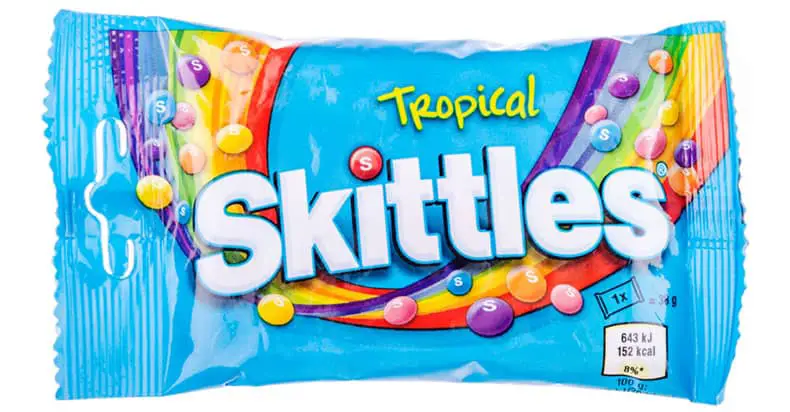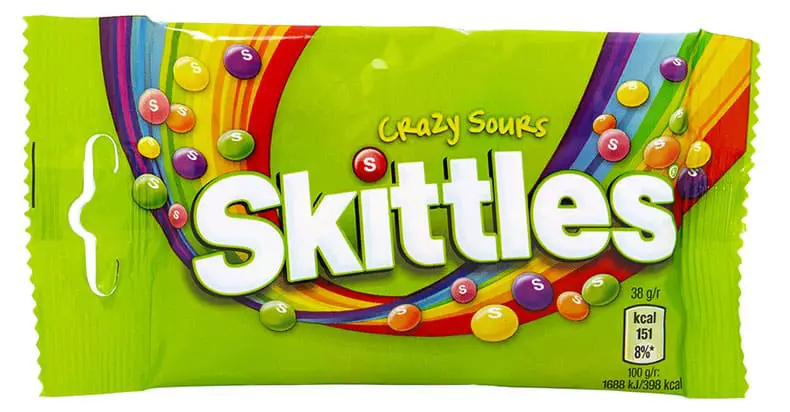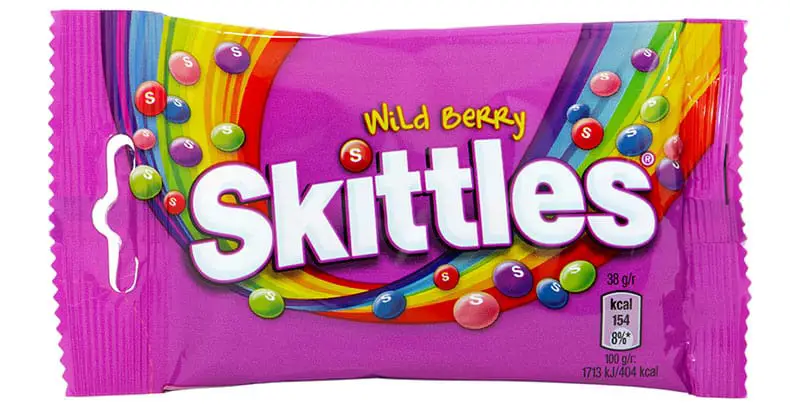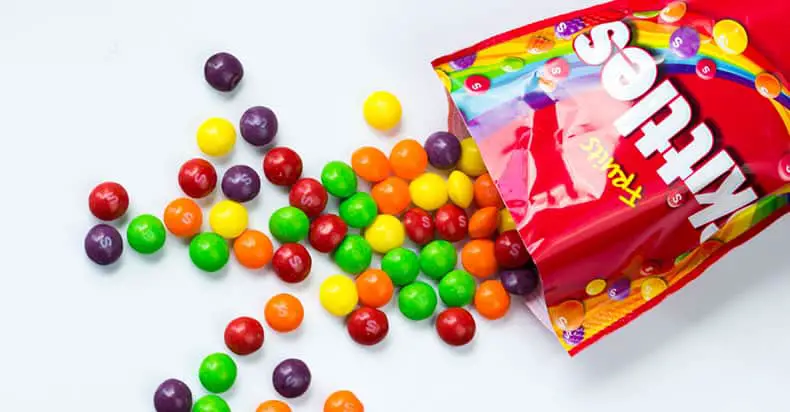Today we’ll be analyzing the suitability of Skittles for those on a vegan diet. Like most lines of candy these days, the brand puts out countless variations. In this article, we’ll be focusing on the original (the red pack), but we’ll also be covering the vegan status of other Skittles products on offer by the brand in 2020.
Are they vegan? Skittles are 100% vegan. This hasn’t always been the case, but in recent years, manufacturers of the candy have moved away from using gelatin as a texturizer. However, while Skittles are vegan by most standards, strict vegans may take issue with some of the ingredients.
As you probably know by now, vegans vary quite a bit in terms of what they’re willing to consume. Today, we’ll be assessing the vegan friendliness of the product by mainstream standards because the most prudent of vegans—those who go out of their way to avoid processed sugar because of bone char—usually rule out processed snacks altogether.
What we’ll do here is go over why the Original Skittles are considered vegan, and then look at the vegan status of a few flavor variations. So, let’s dive in.
Why Skittles Are Considered Vegan
Skittles (all flavors) are made up mostly of sugar, corn syrup, and hydrogenated palm kernel oil. Palm oil poses an issue for some vegans, especially those who adopt the diet due to concerns about the environment.
It is true that palm oil production has negative effects on the environment due to deforestation and greenhouse gases. But, most mainstream organizations don’t view the ingredient as off-limits for vegans, because the aforementioned concerns are not unique to palm oil plantations.1
I.e. soybean and other crops may not threaten orangutans, but their cultivation does result in habitat loss for other species.
Aside from the main ingredients, Skittles also contains citric acid, various starches (modified food starch, tapioca dextrin, and modified corn starch), natural and artificial flavors, colors (Red 40 Lake, Red 40, Titanium Dioxide, Yellow 5 and Yellow 5 Lake, Yellow 6 and Yellow 6 Lake, Blue 1, Blue 1 Lake, Blue 2 Lake), sodium citrate, and carnauba wax.
Artificial flavors make up another category of ingredients that some vegans like to avoid if possible. Usually, because food label requirements don’t necessitate that manufacturer’s list the details.
But as discussed in the article on Fruit Roll-Ups (another vegan fruit-flavored candy) most vegans don’t sweat artificial flavors and colors because the vast majority are synthetic (made in a lab) using non-animal-derived precursors.
But, if you want to go the extra mile in making sure that you avoid all potentially problematic ingredients, you may want to stay away from mainstream processed foods in general, as most will list artificial flavors as an ingredient.
Skittles Contain Vegan-Friendly Colorants
An artificial food coloring agent is one that isn’t found in nature and thus not derived from a natural source.2
This is relevant for our purposes because the only food dye deemed non-vegan belongs to the “natural” food dye category because it’s found in nature. It’s known as Red 4, or carmine, which is derived from beetles.3
Red is probably one of the most notable colors used in Skittles, which is enough to cause many vegans to wonder whether carmine is present. As mentioned above, Skittles contain Red 40, not Red 4, so we’re good to go.
Red 40, aka Allura Red, is a food dye that is made as a byproduct of the petroleum industry, which is why it’s considered a “coal tar” dye. Other petroleum-based dyes present in Skittles include Yellow 5 (tartrazine) and Yellow 6 (Sunset Yellow).4
Skittles Don’t Use Gelatin
This is probably the main point of confusion for most consumers when it comes to the vegan friendliness of Skittles.
In the past, the Vegetarian Resource Group (VRG) has reported Skittles to be both non-vegan and non-vegetarian due to the presence of gelatin.
Gelatin is a pale-yellow semi-translucent substance that’s derived from boiling collagen-containing animal tissue. So, it’s far from cruelty-free. Because it’s derived from animal tissue—not milk or eggs—it’s considered off-limits to vegetarians too.
It turns out, Skittles manufacturers ditched the gelatin as far back as 2009, but it took a while for word to get around. In fact, the VRG was told in 2010 by a Wrigley customer support rep that gelatin was still used after the ingredient had been discontinued in 2009.5
They were told that that Skittles and Starburst candy (both of which are manufactured by Wrigley) contained beef-derived, non-Kosher gelatin. Thankfully, the info turned out not to be true.
A reader of the VRG wrote in informing them that Skittles had altered its formulation earlier that year and was now free of gelatin.
The VRG, of course, had to confirm this, so they went back to Wrigley to corroborate. They said that Skittles underwent a reformulation of its recipe in early 2009, which resulted in the removal of gelatin.
At the time, the formulation was newly altered so Wrigley noted that there were still products in circulation that contained the older formulation—products that had yet to reach an expiration date. Being 2020, this is no longer an issue.
Thankfully, with newer food technology, more and more products are making the switch from gelatin to vegan-friendly alternatives.
In the past, a chewy texture was almost always a red flag because gelatin was a common texturizer used to achieve a chewy consistency.6
Nowadays, food manufacturers often make use of vegan-friendly gums. Gums are either plant-based (e.g. locust bean or carrageenan) or produced microbially.
Vegetable gums like locust bean and carrageenan are always plant-based and thus vegan-friendly.7
Microbe-derived gums are vegan. Xanthan gum used to be considered a possible exception, but today it is largely considered vegan.
It’s produced by bacterial fermentation via Xanthomonas campestris. The cultures are fed sugar as a substrate—usually, sucrose and glucose—but some strains of the bacteria can be cultivated on lactose (milk sugar).8,9
In the past, the ingredient was thought to be processed using egg whites, but the VRG has since exonerated Xanthan gum production as being free of egg whites.10
Skittles Don’t Contain Albumen
Egg white, or albumen, is another common food texturizer that has begun to be replaced by plant-based alternatives.
Albumen is the protein/water mixture that constitutes egg whites and makes up around 58% of an egg’s weight, so the two terms are often used interchangeably.
When spelled with an “i” (albumin) the term refers to the protein that surrounds the egg yolk.11
The ingredient has been used by food manufacturers as an aerator.12
Thankfully, plant-based alternatives exist like various starches and soy protein isolate.13
Skittles Don’t Use Confectioner’s Glaze
There’s a substance called sticklac that female lac bugs secrete when they traverse tree branches. It’s scraped off of trees and filtered to produce shellac which is then used to make a substance called confectioner’s glaze.
The presence of confectioner’s glaze has yielded many an otherwise vegan-friendly candy product unsuitable for many vegans.
I say many vegans because not all in the community regard insect-derived products as off-limits. But, for the most part, confectioner’s glaze is considered non-vegan.
Like beeswax, shellac is used as an edible film on various candy products. Skittles have a nice shiny finish, so it’s not obvious they wouldn’t contain the stuff.
Luckily, Skittles candy makes use of carnauba wax in place of confectioner’s glaze.
Carnauba wax, aka Brazil wax, is obtained from carnauba palm leaves which are collected, dried, and then beaten in order to loosen the wax, which is then refined and bleached.14
Of course, beeswax originates from bees, so it’s regarded the same as honey, another insect-derived food product that’s considered off-limits for vegans by most standards.
As mentioned, not all self-identifying vegans avoid a food product containing substances like confectioner’s glaze or beeswax, but they’re mostly considered non-vegan, and most organizations would agree.15
Thankfully, we needn’t worry about it with this particular candy.
Are Other Flavors Of Skittles Suitable For Vegans As Well?
So now let’s look at flavors other than original and whether or not they’re suitable for vegans.
Are Tropical Skittles Vegan?

This is a new flavor profile you’ll find online and in many grocery stores. The flavors include Kiwi Lime, Banana Berry, Pineapple Passion Fruit, Mango Tangelo, and Strawberry Starfruit.
Tropical Skittles are considered vegan. They contain sugar, corn syrup, palm kernel oil, citric acid, various starches, natural and artificial flavors, coloring agents (no carmine), sodium citrate (a food additive used as a flavorant and preservative), and carnauba wax.16
No problems here.
Are Crazy Sour Skittles Vegan?

Sour Skittles are vegan. They contain essentially the same ingredients as the original, but in different quantities. When a sour variety of an existing vegan candy hits the market, it usually doesn’t spell trouble for 100% plant-based eaters. Any additional ingredients (if present) will be added for tartness, not texture.
These contain corn syrup, sugar, citric acid, palm kernel oil, modified corn starch, tapioca dextrin, natural and artificial flavors, food colorings (Red 40, Red 40 Lake, Blue 1, Blue 1 and 2 Lake, Yellows 5 and 6, Yellow 5 and 6 Lake, and titanium dioxide), sodium citrate, carnauba wax.17
Are Wild Berry Skittles Vegan?

Wild Berry is another popular variation of the candy. The flavor profile includes Strawberry, Wild Cherry, Berry Punch, Melon Berry, and Raspberry.
Wild Berry Skittles are vegan. They simply contain sugar, corn syrup, palm kernel oil, vegan-friendly additives (e.g. citric acid, sodium citrate), starches (tapioca dextrin, modified corn starch), natural and artificial flavors, colors, and carnauba wax.18 No carmine or confectioner’s glaze.
Are Zombie Skittles Vegan?
This is a version you’ll encounter from time to time, especially around Halloween.
Zombie Skittles are vegan. They contain the traditional flavors along with a secret “Rotten Zombie” flavor included as an element of surprise. Luckily, all flavors (including the mystery flavor) are vegan. This variety contains the same as the original Skittles, just in different quantities.
Specifically, the flavors include sugar and corn syrup, hydrogenated palm kernel oil, citric acid, sodium citrate, carnauba wax, starches, natural and artificial flavors, and vegan-friendly food colorings.19
Are Skittles Suitable For Vegans And Cruelty Free? Conclusion
I’m sure you’re happy to see that all flavors are considered vegan-friendly by most standards. If you’re a particularly strict vegan, you may want to opt for candy products that use organic sugar (which is never processed with bone char). If you’re an eco vegan and want to avoid palm oil, there are plenty of other fruit-flavored candies on the market to choose from.
That’s it for the vegan status of Skittles. Thanks for reading.
References
- PETA UK. What is PETA’s stance on palm oil? https://www.peta.org.uk/faqs/
- NATCOL, 2015. Position on the Term “Natural Colour” and the Categorisation of Food Colours. https://natcol.org/wp-content/uploads/2019/03/Updated-NATCOL-Position-Paper-on-Natural-Colours-Final-2015.pdf
- Bug-Based Food Dye Should Be Exterminated, Says CSPI. https://cspinet.org/news/bug-based-food-dye-should-be-exterminated-says-cspi-20060501
- Kobylewski, S., Jacobson, M.F., 2010. Food Dyes. A Rainbow of Risks. Center of Science in the Public Interest (Online) http://cspinet.org/new/pdf/food-dyes-rainbow-of-risks.pdf
- New Formulation Skittles Are Gelatin-Free; Starbursts & Gummi Bursts Contain Non-Kosher Gelatins. https://www.vrg.org/blog/2010/12/30/new-formulation-skittles-are-gelatin-free-starbursts-gummibursts-contain-non-kosher-gelatins/
- Chocolates and Confections: Formula, Theory, and Technique For the Artisan Confectioner (Page 273). Peter Greweling-Ben Fink – John Wiley & Sons – 2013
- Understanding Food: Principles and Preparation (Page 271). Amy Brown – Wadsworth Cengage Learning – 2011. ISBN-10: 0-538-73498-1
- EFSA Panel on Food Additives and Nutrient Sources (14 July 2017). “Re‐evaluation of xanthan gum (E 415) as a food additive”. EFSA Journal. European Food Safety Authority. 15 (2): e04909.
- Tortora, G.J., Funke, B.R., & Case, C.L. (2010). Microbiology: An Introduction, 10th edition. San Francisco: Benjamin Cummings. Pg. 801.
- Xanthan Gum Is Vegan – No Egg Whites. https://www.vrg.org/blog/2018/06/28/xanthan-gum-is-vegan-no-egg-whites/
- Understanding Food: Principles and Preparation (Page 250). Amy Brown – Wadsworth Cengage Learning – 2011
- Chocolates and Confections: Formula, Theory, and Technique For the Artisan Confectioner (Page 356). Peter Greweling-Ben Fink – John Wiley & Sons – 2013
- Chocolates and Confections: Formula, Theory, and Technique For the Artisan Confectioner (Page 363). Peter Greweling-Ben Fink – John Wiley & Sons – 2013
- Carnauba Wax. https://en.wikipedia.org/wiki/Carnauba_wax
- Animal-derived Ingredients Resource | Living https://www.peta.org/living/food/animal-ingredients-list/
- Skittles Tropical Bite Size Candies – 2.17-oz. Bag. https://allcitycandy.com/products/skittles-tropical-chewy-candy-2-17-oz-bag
- Skittles Sour Bite Size Candies – 1.8-oz. Bag. https://allcitycandy.com/products/skittles-sour-4
- Skittles Wild Berry Bite Size Candies – 2.17-oz. Bag. https://allcitycandy.com/products/skittles-wild-berry-4
- Zombie Skittles Review. https://lolcandy.com/zombie-skittles/

